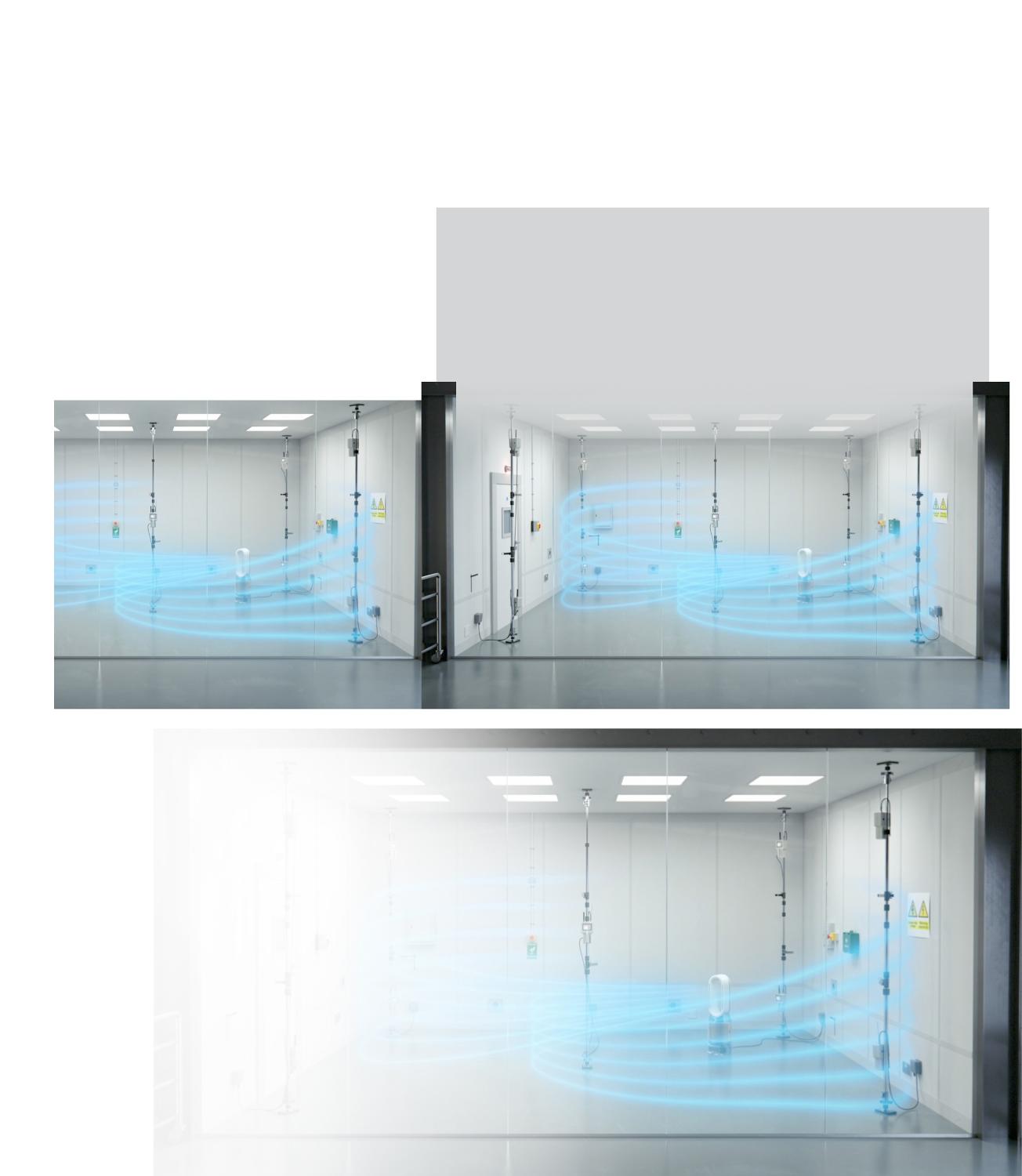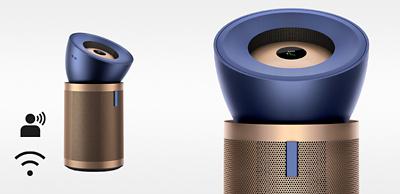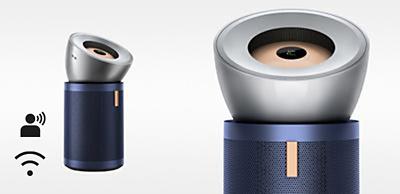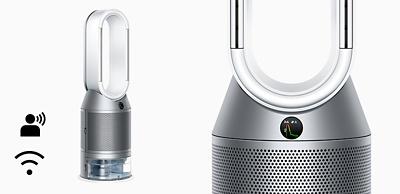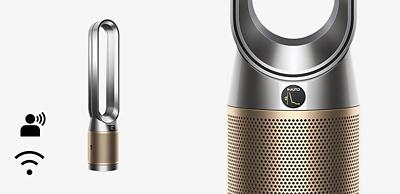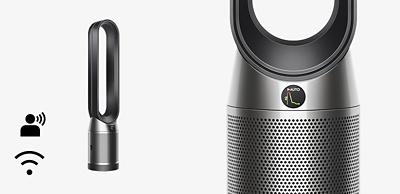
The Dyson indoor
pollution guide
Check which pollutants could be hiding where you live by exploring this indoor pollution guide and also find the right Dyson Purifier for your home.
Many indoor activities and household products emit pollution
Cooking, cleaning, even getting ready for work can release inhalable pollutants into your home.
Dyson air purifiers automatically diagnose your air quality – sensing and capturing airborne particles, and displaying real-time reports on the LCD screen or your MyDyson™ App.
This is a carousel with slides. Use Next and Previous buttons to navigate, or jump to a slide with the slide dots.
Common pollutants found in the home
We're spending more time indoors, in increasingly well-insulated homes and workplaces. Over time, these common indoor air pollutants can build up.

Common pollutants found in the home
We're spending more time indoors, in increasingly well-insulated homes and workplaces. Over time, these common indoor air pollutants can build up.
VOCs in aerosols and cleaning products
Volatile organic compounds (VOCs) are potentially harmful gases emitted by household sprays, air fresheners and personal care products. If used regularly in unventilated rooms, VOC concentrations increase.

VOCs in aerosols and cleaning products
Volatile organic compounds (VOCs) are potentially harmful gases emitted by household sprays, air fresheners and personal care products. If used regularly in unventilated rooms, VOC concentrations increase.
Fumes from paints and furniture
Another potentially harmful gas is formaldehyde, released by some furniture, paints, mattresses, carpets and fireplaces. Most homes contain formaldehyde, but amounts spike during interior decoration projects.

Fumes from paints and furniture
Another potentially harmful gas is formaldehyde, released by some furniture, paints, mattresses, carpets and fireplaces. Most homes contain formaldehyde, but amounts spike during interior decoration projects.
Pollutants released by cooking
Cooking can release a unique mix of combustion pollutants and airborne particles. Even after cooking, odours and potentially harmful contaminants can remain in the air.

Pollutants released by cooking
Cooking can release a unique mix of combustion pollutants and airborne particles. Even after cooking, odours and potentially harmful contaminants can remain in the air.
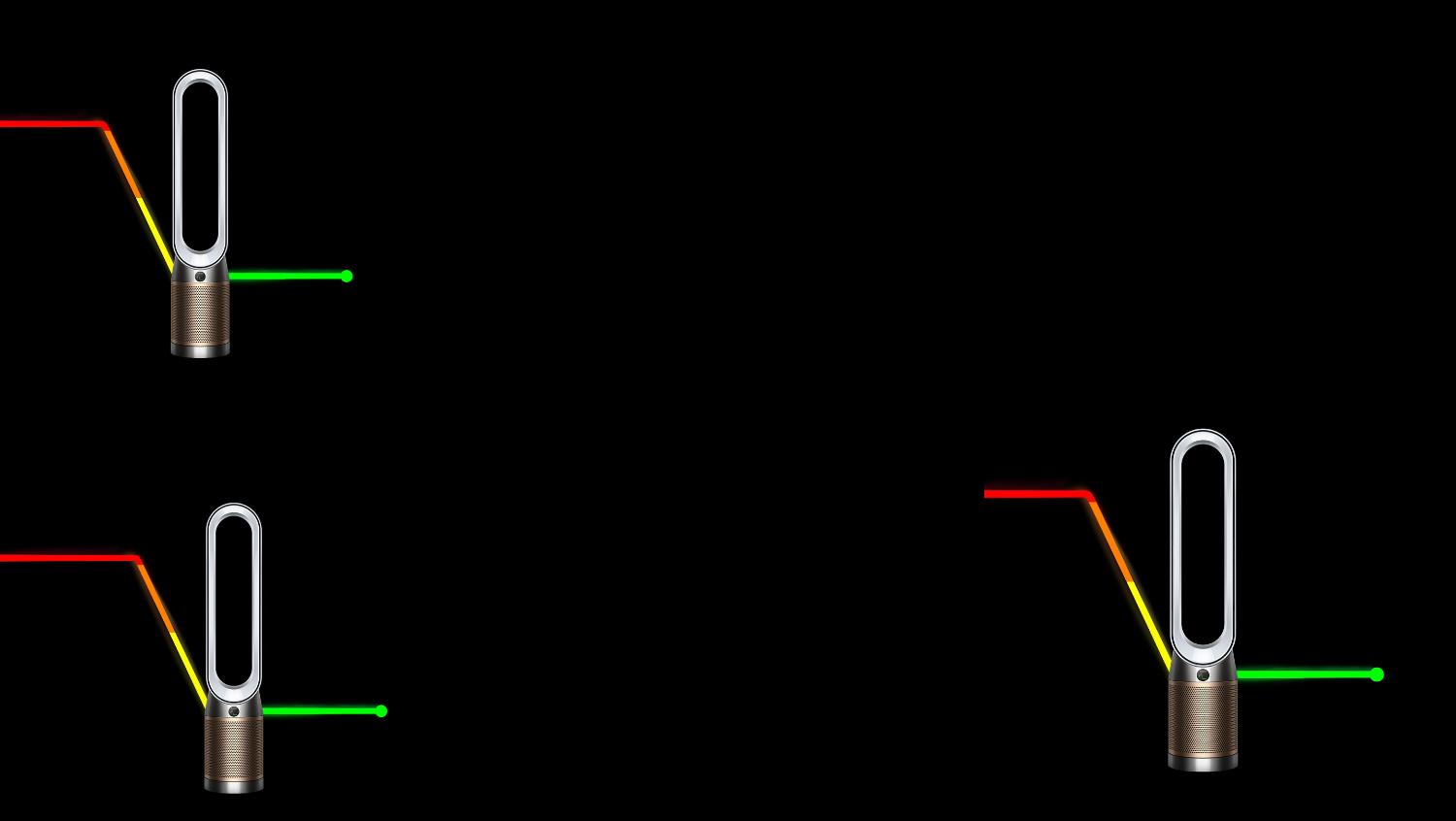
Three key things to look for in an air purifier
Automatic sensing, a fully-sealed machine and long-range air projection are key to effective air purification. That's why they're at the core of our technology. And why we've been testing them for generations.
Tested for real homes
Standard Clean Air Delivery Rate (CADR) tests in small chambers with ceiling fans don't represent real living conditions.
So our engineers spent years developing a new testing methodology, called Point Loading Auto Response (POLAR), to measure real-world performance more accurately.
Find the right purifier for you
Try our indoor air pollution guide and find out which purifier is right for you and your home.
Choose your model
Dyson Purifier Big+Quiet Formaldehyde BP04 (Prussian Blue/Gold)
1833
Dyson Purifier Big+Quiet Formaldehyde BP04 (Prussian Blue/Gold)
5
Star
1582
4
Star
121
3
Star
34
2
Star
19
1
Star
77
Projects air over 32 feet to purify a large space.¹ Quietly.
Detects and destroys formaldehyde, permanently.⁴ Removes gases and odours.²
Only at Dyson: exclusive K-Carbon filter technology captures 3x more NO₂ ³, and CO₂ sensor reports CO₂ levels in real-time.
3 accessories included
See all Hide-
Remote control
Curved and magnetized to store neatly on the machine.

-
K-Carbon filter
Captures 3x more NO₂. Genuine Dyson Activated K-Carbon Filter lifespan is every 2 years or when alerted by the MyDyson™ app.

-
HEPA filter
Genuine Dyson HEPA Filter lifespan is 5 years.

- Limited time offer. Terms and conditions apply.
- Bundle and save $300 on AM07 Dyson Cool™ tower fan. While supplies last.
- Limited time offer. Terms and conditions apply.
- Limited time offer. Terms and conditions apply.
Dyson Purifier Big+Quiet Formaldehyde BP03 (Bright Nickel/Prussian Blue)
1833
Dyson Purifier Big+Quiet Formaldehyde BP03 (Bright Nickel/Prussian Blue)
5
Star
1582
4
Star
121
3
Star
34
2
Star
19
1
Star
77
Projects air over 32 feet to purify a large space.¹ Quietly.
Detects and destroys formaldehyde, permanently.⁴
Remove gases and odours.²
3 accessories included
See all Hide-
Remote control
Curved and magnetized to store neatly on the machine.

-
HEPA filter
Genuine Dyson HEPA Filter lifespan is 5 years.

-
Activated carbon filter
Captures NO₂. Genuine Dyson Activated Carbon Filter lifespan is every 2 years or when alerted by the MyDyson™ app.

- Limited time offer. Terms and conditions apply.
- Bundle and save $300 on AM07 Dyson Cool™ tower fan. While supplies last.
- Limited time offer. Terms and conditions apply.
- Limited time offer. Terms and conditions apply.
Dyson Purifier Humidify+Cool PH2 De-NOx (White/Gold)
1145
Dyson Purifier Humidify+Cool PH2 De-NOx (White/Gold)
5
Star
896
4
Star
132
3
Star
29
2
Star
18
1
Star
70
Advanced air purification automatically captures 50% more NO₂. Even destroys formaldehyde.
Captures 99.97% of ultra-fine particles. Removes odors and gases. Purifies and hygienically humidifies the whole room. Also cools you in summer.
Only at Dyson: exclusive De-NOx technology captures 50% more NO₂ and White/Gold colourway.
2 accessories included
See all Hide-
Remote control
Curved and magnetized to store neatly on top of the machine

-
360° Combi HEPA + K-Carbon air purifier filter
Combined HEPA + K-Carbon filter

- Limited time offer. Terms and conditions apply.
- Bundle and save $300 on AM07 Dyson Cool™ tower fan. While supplies last.
- Limited time offer. Terms and conditions apply.
- Limited time offer. Terms and conditions apply.
Dyson Purifier Humidify+Cool PH03 (White/Silver)
245
Dyson Purifier Humidify+Cool PH03 (White/Silver)
5
Star
102
4
Star
50
3
Star
24
2
Star
23
1
Star
46
HEPA H13 purifier, humidifier and fan. Ideal for larger spaces.
Removes 99.97% of pollutants as small as 0.3 microns.
Automatically senses and displays real-time air quality, humidifies your whole room and helps keep skin hydrated.
2 accessories included
See all Hide-
Remote control
Curved and magnetized to store neatly on top of the machine.

-
360° Glass HEPA and Activated Carbon Filter
360 Combi Glass HEPA + Carbon air purifier 2-in-1 filter. We recommend replacing your filter every 12 months or when notified by your machine.

- Limited time offer. Terms and conditions apply.
- Bundle and save $300 on AM07 Dyson Cool™ tower fan. While supplies last.
- Limited time offer. Terms and conditions apply.
- Limited time offer. Terms and conditions apply.
Dyson Purifier Hot+ Cool HP2 De-NOx (White/Gold)
376
Dyson Purifier Hot+ Cool HP2 De-NOx (White/Gold)
5
Star
251
4
Star
58
3
Star
22
2
Star
14
1
Star
31
Advanced air purification automatically captures 50% more NO₂. Even destroys formaldehyde.
Captures 99.97% of ultra-fine particles. Removes odors and gases.
Purifies and heats the whole room evenly. Cools you in summer.
2 accessories included
See all Hide-
Remote Control
Curved and magnetized to store neatly on top of the machine.

-
360° Combi HEPA + K-Carbon air purifier filter
Combined HEPA + K-Carbon filter

Dyson Purifier Hot + Cool HP1 (Black/Nickel)
254
Dyson Purifier Hot + Cool HP1 (Black/Nickel)
5
Star
148
4
Star
32
3
Star
16
2
Star
13
1
Star
45
Heats your whole room and cools you, with premium air purification.
Captures gases and 99.95% of pollutants, automatically. For a healthier home.
Connect to the MyDyson™ app. Only at Dyson: Exclusive Black/Nickel colourway.
2 accessories included
See all Hide-
Remote control
Curved and magnetized to store neatly on the machine.

-
360° Glass HEPA and Activated Carbon Filter
360 Combi Glass HEPA + Carbon air purifier 2-in-1 filter. We recommend replacing your filter every 12 months or when notified by your machine.

- Limited time offer. Terms and conditions apply.
- Bundle and save $300 on AM07 Dyson Cool™ tower fan. While supplies last.
- Limited time offer. Terms and conditions apply.
- Limited time offer. Terms and conditions apply.
Dyson Purifier Hot + Cool HP1 (White)
254
Dyson Purifier Hot + Cool HP1 (White)
5
Star
148
4
Star
32
3
Star
16
2
Star
13
1
Star
45
2 accessories included
See all Hide-
Remote control
Curved and magnetised to store neatly on the machine.

-
360° Glass HEPA and Activated Carbon Filter
360 Combi Glass HEPA + Carbon air purifier 2-in-1 filter. We recommend replacing your filter every 12 months or when notified by your machine.

- Limited time offer. Terms and conditions apply.
- Bundle and save $300 on AM07 Dyson Cool™ tower fan. While supplies last.
- Limited time offer. Terms and conditions apply.
- Limited time offer. Terms and conditions apply.
Dyson Purifier Cool PC2 De-Nox (White/Gold)
580
Dyson Purifier Cool PC2 De-Nox (White/Gold)
5
Star
459
4
Star
67
3
Star
15
2
Star
10
1
Star
29
Advanced air purification automatically captures 50% more NO₂. Even destroys formaldehyde.
Captures 99.97% of ultra-fine particles. Removes odors and gases. Purifies the whole room evenly. Cools you with powerful airflow in summer.
Only at Dyson: exclusive De-NOx technology captures 50% more NO₂ and White/Gold colourway.
2 accessories included
See all Hide-
Remote Control

-
360° Combi HEPA + K-Carbon air purifier filter
Combined HEPA + K-Carbon filter

- Bundle and save $300 on AM07 Dyson Cool™ tower fan. While supplies last.
Dyson Purifier Cool Formaldehyde TP09 (Nickel/Gold)
2512
Dyson Purifier Cool Formaldehyde TP09 (Nickel/Gold)
5
Star
1890
4
Star
288
3
Star
96
2
Star
83
1
Star
155
2 accessories included
See all Hide-
Remote Control

-
360° Glass HEPA and Activated Carbon Filter
360 Combi Glass HEPA + Carbon air purifier 2-in-1 filter. We recommend replacing your filter every 12 months or when notified by your machine.

- Bundle and save $300 on AM07 Dyson Cool™ tower fan. While supplies last.
Dyson Purifier Cool TP07 (Black/Nickel)
1705
Dyson Purifier Cool TP07 (Black/Nickel)
5
Star
1281
4
Star
202
3
Star
81
2
Star
50
1
Star
91
2 accessories included
See all Hide-
Remote control
Curved and magnetized to store neatly on the machine

-
360° Glass HEPA and Activated Carbon Filter
360 Combi Glass HEPA + Carbon air purifier 2-in-1 filter. We recommend replacing your filter every 12 months or when notified by your machine.

- Limited time offer. Terms and conditions apply.
- Bundle and save $300 on AM07 Dyson Cool™ tower fan. While supplies last.
- Limited time offer. Terms and conditions apply.
- Limited time offer. Terms and conditions apply.
Dyson Purifier Cool PC1 (White)
337
Dyson Purifier Cool PC1 (White)
5
Star
208
4
Star
44
3
Star
26
2
Star
29
1
Star
30
2 accessories included
See all Hide-
Remote control
Curved and magnetized to store neatly on top of the machine.

-
360° Glass HEPA and Activated Carbon Filter
360 Combi Glass HEPA + Carbon air purifier 2-in-1 filter. We recommend replacing your filter every 12 months or when notified by your machine.

- Limited time offer. Terms and conditions apply.
- Bundle and save $300 on AM07 Dyson Cool™ tower fan. While supplies last.
- Limited time offer. Terms and conditions apply.
- Limited time offer. Terms and conditions apply.
Promotion
Frequently asked questions
Indoor air pollution contains a mix of pollutants, including particulate matter (PM) and volatile organic compounds (VOCs).
Many indoor activities and household products release invisible pollutants. As our homes become increasingly well-sealed, it may seem like we're shutting pollution out – but in truth, we may be shutting it in.
Four indoor air pollutants which may be causing poor air quality in your home are:
Mould. Moulds are fungi that reproduce by making and releasing spores. It's usually found where there is excess moisture.
Volatile organic compounds. Or VOCs, can be released from building materials, personal care and cleaning products.
Particulate matter. These can include dust, smoke and exhaust fumes. Particles vary from PM0.3 - PM10 in size.
Allergens. Common allergens include pollen and pet dander. Biological pollutants from pets include multiple proteins in a pet’s fur, hair, saliva, urine or dander.
Dyson's sealed HEPA filters capture 99.97% of microscopic allergens and pollutants as small as 0.3 microns.
Here are a few actions you can take to improve the air quality in your home:
Invest in an air purifier. Your best solution for improving your indoor air quality is an air purifier. Be sure to choose one which automatically senses, is fully sealed, and has long-range air projection.
Get rid of dust. House dust can be a combination of dust mites, pet dander and pollen. Keeping on top of cleaning and vacuuming can help overall air quality.
Source control. Reduce pollution sources in your home (like burning scented candles).
Unlike our competitors, every Dyson air purifier is fully sealed to HEPA H13 standard. This ensures we capture 99.95% of ultrafine particles⁴ and prevents pollutants from leaking back into the air you breathe.
VOCs are 'Volatile Organic Compounds', meaning they are compounds containing carbon and are generally a gas at room temperature. Indoor VOCs can come from a range of activities, such as spraying perfumes or hair sprays, painting or cleaning.
When you see VOC on your machine's monitor or in your MyDyson app, you're experiencing a rise in VOCs, and your machine is working hard to remove the pollutant from the air, and project cleaned air into your home.
PM2.5 is particulate matter with a size of 2.5 microns or less, for example dust, ash and smoke particles. These can be released from a range of household activities such as burning candles or cooking.
When you see PM2.5 on your machine's monitor or in your MyDyson app, you're experiencing a rise in PM2.5, and your machine is working hard to remove the pollutant from the air, and project cleaned air into your home.
Get more from your Dyson with the MyDyson™ app*
-
Control air quality, wherever you are
Control your air purifier from anywhere with your smart device, whether you’re traveling, at work, or simply at home on the sofa.
-
Monitor air quality. View reports, fast.
Monitor indoor and outdoor air quality from your smart device. See your machine’s activity as well as temperature, humidity, and filter reports.
-
Automated filter alerts
You’ll never need to worry about when to replace your filter. We’ll let you know. Helping your machine to always perform at its best.
*The MyDysonTM app is only compatible with select Dyson products. For a list of compatible products, please click here.
Exclusive machines and offers
Exclusive machines and offers
Exclusive Dyson machines, unique colour options and special gift editions, only available from DysonCanada.ca and Dyson Demo Stores
Free shipping and returns
Free shipping and returns
What are my shipping options?
Standard shipping: Free
Shipping via Purolator or Canada Post is free of change when ordering a machine from dysoncanada.ca and on all orders from a Dyson Demo Store. We aim to deliver the machine(s) within 2-7 business days, subject to availability. Please note that there are a small number of postal codes, usually in remote rural areas, to which we may not be able to deliver within this timescale.
Expedited shipping: $25
If you prefer to check out with Expedited Shipping, please contact our Customer Care team through the Live Chat icon below, or at 1-877-397-6622 and they will be happy to assist you.
Accessories and Spare Parts: $5.99
Shipping for accessories and spare parts is $5.99. Orders will be shipped within 2-7 business days via Canada Post.
How long does shipping take?
Estimated delivery times to major cities:
Cities |
Standard Shipping (Free) |
Expedited Shipping: ($25) |
To Toronto |
2-5 business days |
2 business days |
To Ottawa |
2-5 business days |
2 business days |
To Montreal |
2-5 business days |
2 business days |
To Quebec |
2-5 business days |
2 business days |
To Winnipeg |
3 -7 business days |
2 business days |
To Halifax |
3 -7 business days |
2 business days |
To Calgary |
3-7 business days |
2 business days |
To Edmonton |
4-8 business days |
2 business days |
To Saskatoon |
3-8 business days |
2 business days |
To Vancouver |
4-8 business days |
2 business days |
To St.John's |
5-10 business days |
2 business days |
When will my delivery arrive?
Delivery is Monday to Friday 9am – 6pm local time, not including statutory holidays. If a delivery cannot be completed (for example, if you’re not home), the carrier will leave a notification at your door indicating where you can pick up your order.
Dyson Canada will make every effort to process orders within this timeframe, but issues outside of our control, such as weather, may cause delays. Dyson Canada will not be held liable for shipping delays in those cases. To process orders within this timeframe, we may need to contact you to validate your credentials.
If ordering multiple products your order may be delivered in multiple shipments. This is to ensure that your order is delivered as soon as possible.
How do I track my order?
You will be sent a notice of shipment email with tracking information upon the shipment of your order.
Can I ship to a PO Box?
Shipping to PO boxes is not available due to package size restrictions.
Can I ship to a different address than my billing address?
Yes you can, however please note that different billing and shipping addresses may cause a slight delay in delivery time due to our order verification process.
What happens if I’m not home to receive my shipment?
Since a signature is always required, please try to make sure someone is home to sign for your package. The carrier will make one delivery attempt, and if nobody is available to sign for the package you'll have two options:
1) Contact your selected carrier to arrange for a second delivery attempt.
or
2) Pick up the package from your local Purolator depot or Canada Post office. In order to determine at which location your package is being held, look up the package using the tracking number shared via email or contact the carrier. Be sure to bring one piece of mail with your name on it and a government-issued ID when you pick up your order.
What happens if my order was ‘returned to sender’?
If your order is not picked up from your either your local Purolator depot or Canada Post office within the time listed on your delivery notice it will be returned to sender. In the event that this happens, please contact Dyson Canada via email at service@dysoncanada.ca or by phone at 1-877-397-6622.
How do I return a product?
Buy risk free with free 30-day returns
Extended Holiday Returns: Any purchases made between the 1st of November 2025 and 25th of December 2025, can be returned up to the 31st of January 2026. Purchases made directly from www.dysoncanada.ca, Dyson Stores or Dyson helpline are eligible for a full money back. The Dyson outlet's refurbished machines are final sale and are not eligible to be returned.
Purchases made directly from www.dysoncanada.ca, Dyson Demo Stores, or Dyson helpline are eligible for a full money-back. The Dyson outlet's refurbished machines are final sale and are not eligible to be returned.
If you wish to return any product purchased from the Dyson Store within the first 30 days, please contact us prior to returning via email at service@dysoncanada.ca or by phone at 1-877-397-6622.
Dyson will cover the cost for the return shipping of any new machines. We will email you a pre-paid return shipping label. Simply print and affix it to the outside of your return shipment, and contact Purolator to arrange for a pick-up or you can drop it off at your local depot.
If you have any queries regarding your order, please contact service@dysoncanada.ca or call us at 1-877-397-6622.
Price match promise
Best price guaranteed
Be confident that you are getting the best price on Dysoncanada.ca. If within 30 days of purchase you should find the same model advertised by an authorized Canadian Dyson retailer at a lower price, we’ll refund you the difference. Just contact our Customer Service team at 1-877-397-6622 to get started. Here’s what you’ll need to know:
• Product must be the exact same model number as it appears on DysonCanada.ca and in stock
• Proof of advertised price by an authorized dealer is required (Copy of Flyer or Website URL)
• Authorized dealers are limited to Amazon 1st party (ships and sold from Amazon.ca), Best Buy, Canadian Tire, Costco, Hudson's Bay, Home Hardware, London Drugs, Lowes, Rona, Rooms+Spaces, Sephora, Shoppers Drug Mart, TSC, Visions and Walmart.
• Product must be new and in original packaging. It cannot be reconditioned (refurbished), used, damaged, returned, open box, "close out", "clearance" or a demonstrator product.
• Product price must not be lower due to an advertising error or misprint
Dyson reserves the right to rescind this offer at any time and/or modify these terms and conditions as needed.
Pay by installments
Affirm (formerly known as PayBright) is one of Canada’s leading installment payment providers. When you use Affirm to pay at Dyson’s checkout, you can split your purchase into easy, automatic monthly payments. To use Affirm as your preferred payment choice at checkout.
1. Add items to your shopping cart as usual, and select Affirm as your payment method at checkout for orders between $100 and $15,000 (including taxes and shipping).
2. Get set up: Use your mobile phone number and email to set up your Affirm plan within 60 seconds. Subject to credit approval.
3. Confirm your payment plan with Affirm. Dyson will process and ship your order as usual.
4. Make monthly payments to Affirm while you enjoy your purchase.
¹In Auto mode.
²Particle challenge by DEHS oil specified in EN1822 within a chamber specified in ASTM F3150. Tested in Max Mode at IBR US, for whole machine efficiency above 99.95%. Gas capture rates vary.
³In maximum setting. Tested for air projection (DTM801) and purification coverage in a 81m³ room (TM-003771).
⁴Particle challenge by DEHS oil specified in EN1822 within a chamber specified in ASTM F3150. Tested in Max Mode at IBR US, for whole machine efficiency above 99.95%.
⁵Dyson purifiers were challenged with airborne influenza A (H1N1 virus), MS2 bacteriophage and Phi-6 bacteriophage at independent labs, using a 30 m3 chamber for 60 minutes or 90 minutes (Phi-6) at maximum fan speed. Dyson Purifiers were also challenged with airborne SARS-CoV-2 (the virus that causes COVID-19) at an independent lab, using a 0.37 m3 chamber for 90 seconds. Real-life efficacy may vary.



